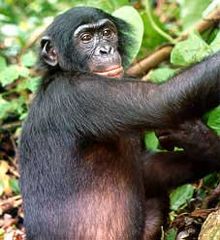The wildlife of the Democratic Republic of the Congo includes its flora and fauna, comprising a large biodiversity in rainforests, seasonally flooded forests and grasslands.


The country is considered one of the 17 megadiverse nations, and is one of the most flora rich countries on the African continent.[1] Its rainforests harbour many rare and endemic species, such as the chimpanzee and the bonobo. It is home for more than 10,000 types of plants, 600 timber species, as well as 1,000 bird species, 280 reptile species, and 400 mammal species, including the forest elephant, gorilla, forest buffalo, bongo, and okapi. Many of these wildlife species are threatened animals such as large lowland gorillas and chimpanzees.[2]
Five of the country's national parks are listed as World Heritage Sites: the Garumba, Kahuzi-Biega, Salonga and Virunga National Parks, and Okapi Wildlife Reserve. All five sites are listed by UNESCO as World Heritage In Danger.
Several environmental issues in the DRC threaten wildlife, including overhunting for bushmeat, deforestation, mining and armed conflict. The civil war and resultant poor economic conditions have endangered much of the country's biodiversity. Many park wardens were either killed or could not afford to continue their work.
Fauna edit
The ecoregion is home to the endangered western lowland gorilla (Gorilla gorilla gorilla), the endangered eastern lowland gorilla (Gorilla berengei graueri), African forest elephant (Loxodonta cyclotis), and okapi (Okapia johnstoni).[citation needed]
Animals native to the Democratic Republic of the Congo:
- Aardvark
- African brush-tailed porcupine
- African buffalo[3]
- African bullfrog
- African civet
- African clawed frog
- African dwarf frog
- African golden cat[3]
- African helmeted turtle
- African leopard
- African manatee
- African palm civet
- African rock python
- African soft-furred rat
- African softshell turtle
- African striped weasel
- African tree toad
- Allen's swamp monkey
- Angola colobus
- Aubry's flapshell turtle
- Ball python
- Banded mongoose
- Banded water cobra
- Bili ape
- Black-and-white colobus
- Black-collared lovebird
- Black mamba
- Black-necked spitting cobra
- Blue duiker
- Blue-headed wood dove
- Blue monkey
- Bohor reedbuck
- Bongo
- Bonobo
- Bushpig
- Cape bushbuck
- Cape hyrax
- Central African oyan
- Chameleon
- Chimpanzee[3]
- Common agama
- Common duiker
- Common egg eater
- Common eland
- Congo peafowl
- Congo water cobra
- Crocodile
- De Brazza's monkey
- Egyptian fruit bat
- African forest elephant
- Western gorilla[3]
- Gaboon viper
- Gallagher's free-tailed bat
- Giant eland
- Giant forest hog
- Giant otter shrew
- Goliath beetle
- Grant's zebra
- Greater cane rat
- Greater kudu
- Great Lakes bush viper
- Green bush viper
- Green mamba
- Grey parrot
- Handsome spurfowl
- Hartebeest
- Hedgehog leaf-toed gecko
- Hippopotamus[3]
- Honey badger
- Jameson's mamba
- Johnston's chameleon
- Katanga Mountain bush viper
- Kob
- Kordofan giraffe
- Leopard tortoise
- Lesser flamingo
- Lichtenstein's hartebeest
- Lion[3]
- Many-banded snake
- Marsh mongoose
- Monitor lizard
- Moustached monkey
- Northern white rhinoceros
- Okapi
- Olive baboon
- Oribi
- Pangolin
- Patas monkey
- Puff adder
- Puku
- Red river hog
- Roan antelope
- Rock hyrax
- Rough-scaled bush viper
- Sable antelope
- Serval
- Side-striped jackal
- Sitatunga
- Southern reedbuck
- Spectral pygmy chameleon
- Spotted hyena
- Strange-horned chameleon
- Stuhlmann's golden mole
- Topi
- Tropical spiny agama
- Trumpeter hornbill
- Upemba lechwe
- Upemba mud turtle
- Warthog
- Waterbuck
- Yellow-backed duiker
Birds edit
Butterflies edit
See also edit
References edit
- ^ Hart, Terese; Robert Mwinyihali (2001). Armed Conflict and Biodiversity in Sub-Saharan Africa:The Case of the Democratic Republic of Congo (DRC) (Report). Washington, D.C.: World Wildlife Fund. Retrieved 15 April 2012.
- ^ Biodiversity and Forest Management in the Congo Basin (PDF). Montreal, CA: Secretariat of the Convention on Biological Diversity and Central African Forests Commission. 2009. ISBN 978-92-9225-152-9. Retrieved 15 April 2012.
- ^ a b c d e f Plumptre, A.J.; Kujirakwinja, D.; Treves, A.; Owiunji, I.; Rainer, H. (2007). "Transboundary conservation in the greater Virunga landscape: its importance for landscape species". Biological Conservation. 134 (2): 279–287. doi:10.1016/j.biocon.2006.08.012.
External links edit
- A blog on bonobo research in Congo
- "Western Conglolian swamp forests". Terrestrial Ecoregions. World Wildlife Fund.
- The Digitised Flora of Central Africa